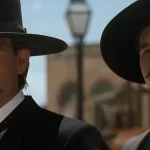The Girl on the Train: Off the Rails, by David Bax
Two years ago, Tate Taylor surprised with Get On Up, a lively, nonlinear biopic that slyly took on the unreliable point of view of its main character. His new film, The Girl on the Train, is no biopic and it’s certainly not lively but it maintains the unreliable, nonlinear structure of its predecessor. Unfortunately, it also adds a bunch of poor decisions like bad and almost entirely unnecessary voiceover, the impenetrable dumbness of which is only overshadowed by the actual dialogue spoken out loud (“I heard once that when a train hits, it can rip the clothes right off you,” a character actually says). In a way, Taylor has surprised us again. No one expected The Girl on the Train to be this much of a dud.
Emily Blunt is Rachel, the girl, a divorced alcoholic whose train ride into the city each day (where she pretends to go to the job from which she was fired) takes her past her old house, which her husband, Tom (Justin Theroux) still lives in with his new wife, Anna (Rebecca Ferguson), with whom he had an affair while married to Rachel. It also takes her past the home of married couple Megan (Haley Bennett) and Scott (Luke Evans), onto whom Rachel has projected her ideals of wedded bliss, based mostly on the fact that they like to make out in their underwear on their deck first thing in the morning. But then Megan, who is also Tom and Anna’s nanny (try to keep up) goes missing during one of Rachel’s vodka-fueled blackouts. Rachel becomes determined to find out what happened, if she had anything to do with it and, finally, what’s going on with Kamal (Edgar Ramirez), Megan’s hot but terrible psychiatrist?
If the plot sounds convoluted, Taylor’s construction of it won’t do you any favors. The film lurches awkwardly from plot point to plot point like a drunk trying not to step on sidewalk cracks while also halting every ten minutes or so to remind you (via that awful voiceover) of the characters’ backstories and relations to one another. The flashbacks are time-stamped with things like “Six Months Ago” but the movie is too clumsy and scattered for us to be sure what the fixed point is from which we’re meant to look six months back. It doesn’t help that no matter how far back we go in time, it seems to be perpetually late autumn.
Perhaps it would have helped if the characters provided an anchor. Unfortunately, they’re like the cast of a bad primetime soap, beautiful but hollow. The only through-line the movie attempts is a regressive depiction of each of its women (Rachel, Megan and Anna) as being solely defined by their pregnancy histories or lack thereof. It’s in this mode, in fact, that The Girl on the Train makes its most offensive error, appearing at one point to offer an insultingly simplified cause and effect relationship for Rachel’s alcoholism.
Taylor’s attempt at structuralism only diffuses the film’s impact more. Cinematographer Charlotte Bruus Christensen (who shot the beautiful Far from the Madding Crowd just last year) gives us a jittery handheld look that’s become all too familiar. And the fractured editing, with its jump cuts and ellipses, only serves to muddle the coherence. These are intended as organic extensions of Rachel’s own mindset but they read as aesthetic affectations.
The Girl on the Train, in trying to get us into its protagonist’s shattered psyche, goes too far, alienating us from its very soul. It’s unclear, first, whether we’re supposed to know if Rachel had anything to do with Megan’s disappearance. More importantly, it’s unclear how to feel about it. The intended emotions have dissolved as in a stew, no longer depending on one another. Or, more appropriately, they’re like a train with all of its cars disconnected.





























